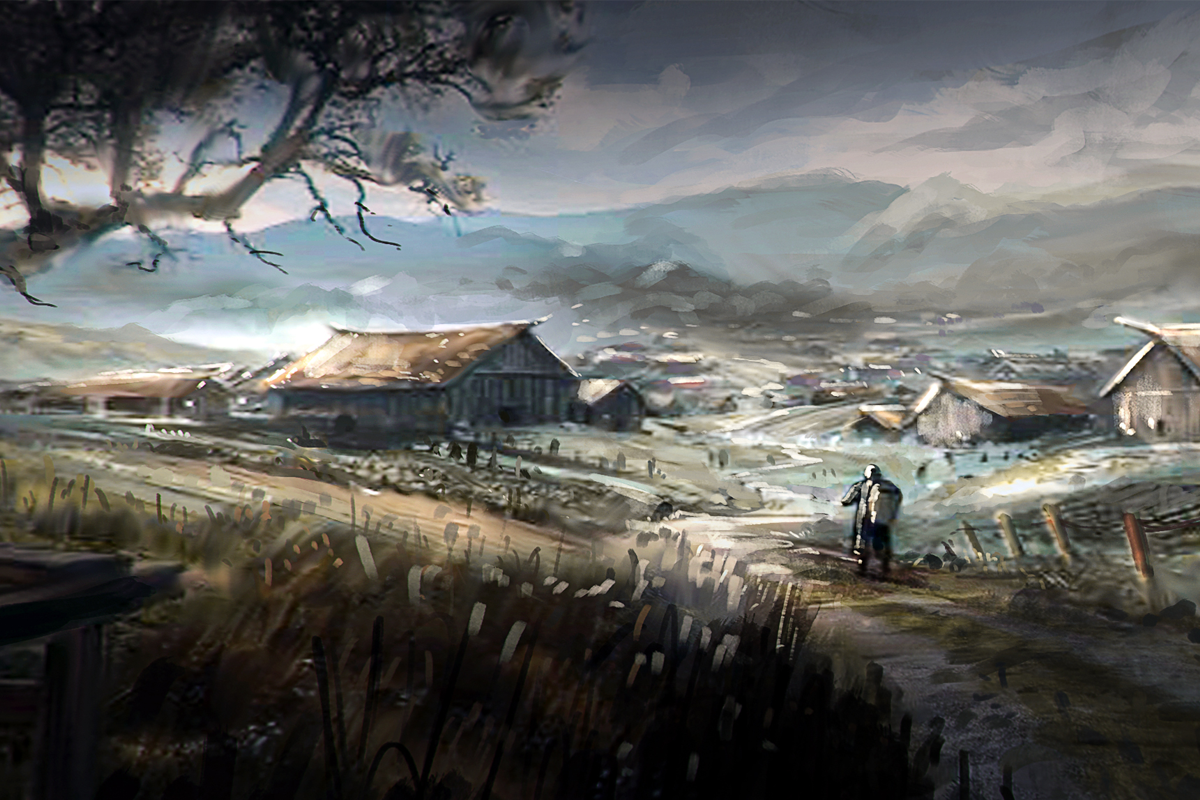How to Make a Homebrew D&D Campaign Setting
Ready for your first time creating a homebrew D&D campaign but unsure where to start? There are many ways to start a homebrew campaign. I am going to walk you through one of my simple methods for creating a D&D campaign setting.
The one thing to keep in mind as your read through this campaign builder guide is your preferences take precedent. I fully admit my process is heavily influenced by what I am going to call “traditional fantasy roleplaying game” tropes. There is a whole new world of fantasy culture developed around modern heroic fantasy, fantasy video games, and anime which I am not overly familiar. My lack of familiarity means I may be missing out on themes, adventure hooks, and plot elements that you personally love.
My lack of knowledge does not mean you cannot use this framework for your campaign but when it comes to the themes and lines of conflict for the campaign, you will want to overlay your influences or outright replace the elements I’ve included in the workbook. In terms of a framework, consider the workbook to be only one tool at your disposal, to use and ignore as you see fit in order to create the campaign world in which your and your players’ stories will come alive.
The Local to Global Method
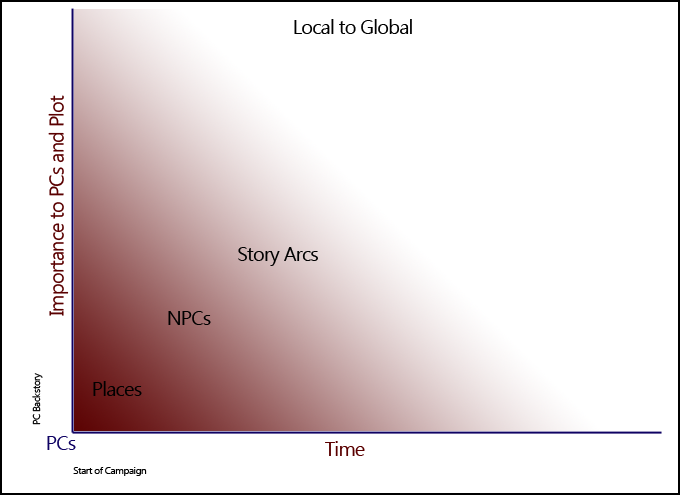
There are a few different ways in writing a campaign setting for D&D (or for any roleplaying game). I won’t detail all of them here, but I want to let you know that there are other options.
I find the Local to Global (can also be called Bottom-Up) to be the easiest way to get started with a campaign because it means you don’t have to know everything about the world before getting started. The core concept is starting with the world elements the player characters (PCs) will interact with first and then expand outward.
This process means you only need a basic idea of the bigger elements at play and can adjust those elements to reflect the actions and themes the PCs bring to the surface while they are playing.
It also means you get more elbow room to improvise elements of the campaign world. Your prep time can be spent on the parts of the world your players will experience instead of on elements with no immediate impact on them.
The other effect of using the Local to Global method is it is easier to control the encounters and scale them for the PCs. While it might be nice to have a true sandbox setting where the players can accidentally stumble upon a Dracolich on their first day of adventuring, it might be very frustrating for your players and actually hinder their desire for adventure.
I am not preventing you from creating those situations, and there should be challenges the PCs cannot face immediately, but I try to avoid outright killing the PCs with overpowered encounters right from the start. We can get into DM philosophy, but I believe part of our job is to help cultivate heroes which means giving them time and room to grow and develop. Mistakes at the beginning should be more humiliating than fatal.
Lines of Conflict
Story requires conflict. For your campaign world to feel dynamic you should have multiple lines of conflict. Within the Campaign Workbook, I have you define three lines of conflicts: a natural conflict, a political conflict, and a martial conflict.
You could easily change these up any way you want, but I find with three unique conflicts with three unique ways to handle them helps the PCs see all the tools available to them to find solutions.
Three Types of Conflicts

A Natural Conflict
A natural conflict can be something as simple as a rockslide that has cut off a roadway to another village. It can also be as complex as an ancient curse that has been put upon the land. The concept of “natural” in a magical world is stretched a bit. The idea of a natural conflict is it cannot be solved using a sword, by stealing something, or talking your way out of it. A natural conflict is solved through problem solving and complex coordination.
A Political Conflict
A political conflict tends to have more social solutions. The PCs don’t need to be directly connected to the political conflict but they need to be affected by it. Think about rival families. The PCs don’t need to be members of the families but could be hired by them, or associated with them in some way. Other political conflicts can be between the village/settlement and a regional authority. Conflicts between guilds or guildmembers, between two villages, between workers and the boss, or the village and outsiders are all political conflicts.
A political conflict can flare up into a violent conflict, but it doesn’t necessarily have to be solved with violence. There may be other solutions to the problem.
A Martial Conflict
A martial conflict is at its core a military conflict. A roving band of goblins or kobolds, a nearby ogre, a foreign militia, cultists, and even just a band of bullies in the town are all conflicts that might require physical conflict to resolve. The PCs might be able to solve the problem using non-violent means, though, so be prepared for some out-of-the-box thinking.
This actually applies to all conflicts. Avoid scripting the solution, let the players explore different ways to resolve them.
One Conflict Can Create Many Adventures
Conflicts are not adventures. Conflicts put adventures in a framework, they provide context for an adventure. Think about why someone goes on an adventure. What transforms a town guard into a fighter that explores a crypt filled with undead? Why would a thief who makes a nice living pick pocketing suddenly want to join a group of others to fight off bandits who are hijacking wagons delivering grain to the village?
Don’t think of the conflicts with easy solutions. The rivalry between the Capulets and the Montagues wasn’t resolved, even with the deaths of Romeo and Juliet, and yet it provided a lot of conflict, including sword fights in the street.
Themes for Campaigns

As you build out the lines of conflict the PCs initially encounter, you may want to start thinking about the greater themes of the campaign. A curse on the land may tie into something bigger. A plague could have been unleashed by a tomb that was raided for an artifact being used by some villain for a nefarious plan.
The themes provide the bigger framework of the campaign. Is it good vs evil? Corruption? Greed? Security?
Some other themes we see in fantasy stories you can tap into:
- Tradition vs. Change
- People vs Society
- People vs. Nature
- People vs. Themselves
- Coming of Age
- Love
- Quest
- Loyalty/Betrayal
- Epic journey
Avoid themes centering the story on one individual. This makes it more about one PC instead of the group of PCs. So avoid the “lost heir”, “missing messiah”, and “reluctant hero” themes. Also don’t be afraid of more common themes, like Family, Honor, or Revenge. Revisit all those books we read in English class in high school. There is a reason why those books are studied. Their themes are pretty timeless.
These themes do not need to be decided on immediately. In fact the Campaign Workbook doesn’t even have you detail the themes. I am reluctant to start with theme details until I have an understanding of what my players find fun, then I can lean into those story ideas and develop the theme which they will find entertaining and compelling. That is my way of doing it, you will find your own way. If you think starting with the theme is important, then do it.
The Campaign Builder Workbook is used to get you to think of some of the bigger story concepts as well as the nuts and bolts for some of the first adventure hooks to offer the players. You can revisit different sections, change things as you need to adjust for the actions of the PCs. I assure you that as you play you will find new ways of layering the details of the different stories to create something unique and memorable that your players will love.
How to Use the Campaign Builder Workbook
The Campaign Builder Workbook does not do any of the heavy lifting for your campaign. What it does do is provide a system to help take all the variables of the campaign and organize them in a Local to Global fashion. You most likely have some semblance of a campaign in your head but wrangling all those details and variables can be tricky. This is just a tool to help your take all those ideas and put them into a fashion where you can craft adventures around them.
Local to Global just means building out the campaign from the first non-player characters (NPCs) and locations the PCs interact with to the NPCs and locations that are in the NPCs future. Since geography is a key part of a fantasy RPG, this method uses starting location and the world at large as a framework. Letting the players learn and know a specific area of the world in which they are playing will make them more invested in the overall campaign. They will have developed a relation with these early NPCs and will have a reason to be concerned about their welfare and lives.
The entire workbook does not need to be completed before starting to play, but you should fill out the entire Campaign Survey section as well as the Starting Village section as that information will give your campaign the foundation from which everything else will spring forth.
Campaign Survey
If you are using the Campaign Builder Wookbook as a spreadsheet, as you enter information on the Campaign Survey, it will push that information to the other tabs in the workbook where you will expand upon them, filling in additional details. If you are using it as a PDF then you will have more manual action to take and will need to reference a few tables to help put your campaign together.
Starting village
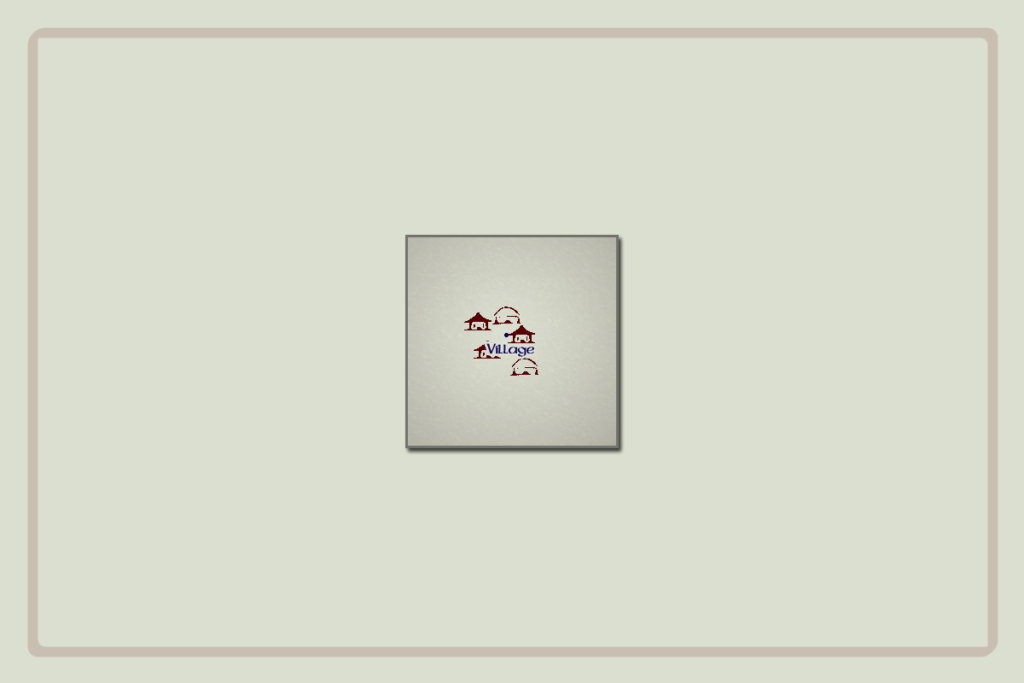
I think the idea of a “starting village” began with the published adventure T1 – The Village of Hommlet. A village provides a “safe space” from which the PCs can begin their adventure. There is enough opportunity in a starting village for beginning adventurers to earn some rewards, but the village should be small enough to lack the services, challenges, and rewards a more powerful character will need.
The Campaign Builder Workbook allows for a starting village the size of a large city. I do not recommend starting in large cities since cities offer enough adventure in the city, that adventurers have no reason to risk going out into the wilderness. Wilderness is the unexplored territory, or forgotten territory. This is where there will be ruins, lost temples, forgotten mines, dangerous caverns, monster havens, mysteries and wonders at the heart of exciting adventures.
What this section will not do for you is bring life to your village. This is the bare bones of what your starting location is about. You can take a published adventure and use that as your starting village. You can create your own, or used a random village generator. The one thing to keep in mind with all these solutions is the life of the village is not the stat blocks of the NPCs. It is within you as the DM. The village will be as dynamic and alive as you make it.
I don’t want to dip too far into the DM advice pool, but a village is a place of activity. People don’t wait in silence for adventurers to approach them. They have kids they are raising. They have chores that need to be done. Animals to be taken care of. There are buildings that need to be built, social events to attend, and fences to be mended literally and figuratively. Watch the first season of Little House on the Prairie to get a sense of what village life is like. Then watch shows like Hart of Dixie, Gilmore Girls, Northern Exposure, True Blood, Stranger Things, Twin Peaks, Jericho, and Friday Night Lights to get a sense of how to bring a small town community to life.
Every person in town has a personality and personal goals. They may be failed adventurers who now run a shop or successful adventurers who have settled down to be a farmer. They have love interests, secrets, and hobbies. They have the wisdom of the ages and are dumb as a box of non-sentient rocks. Your villagers can be a bit weird and lovable as well as stubborn and mean. The PCs may only get a peek behind the curtain of some of this stuff, but it is what brings life to a village.
The gruff mill owner always picking a bouquet of wildflowers to leave on the steps of the Widow Marsdale’s home without her ever realizing it is him doing it could be his way of showing affection for her or an expression of guilt he feels for being the cause of her husband’s death. These are barely side quests for an adventurer but I assure you these are the moments that if uncovered by the PCs will make them think you are a genius and fall in love with their adopted home.
Village Name
Go nuts, it is your village. I am the last person to offer advice on naming villages. I like literal names like Crossroads or Seawatch but no matter what you name it, one of your players will make fun of it. Get used to it. Try to avoid naming villages something overly complex and make sure it is easy to pronounce. I know how easy it is when writing to piece together something that looks good but when you and others try to pronounce it, gets muddled.
Village Government
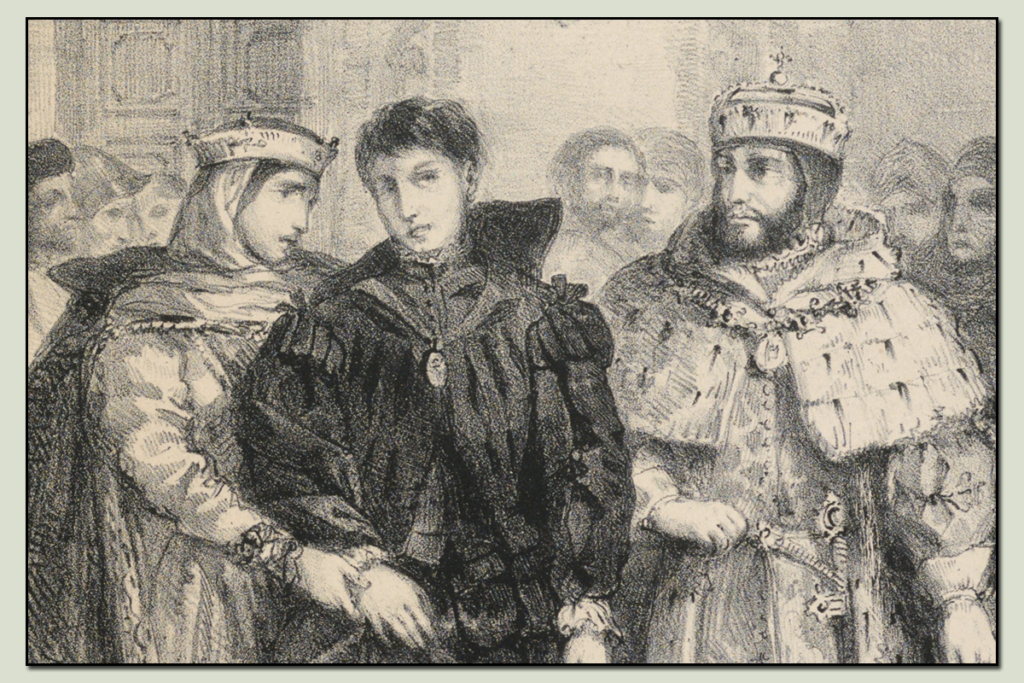
How is the village governed? This says a lot about the people who live in the village. Don’t spend too much time worrying about the exact political structure, how elections are handled, or anything like that. Think in broad strokes, the basics, just enough to reveal to players so they understand the location in which they are playing.
- Elected Mayor – Once in a while, the village holds an election to choose a mayor who then runs the administration of the town.
- Elder Council – The oldest (presumably wisest) members of the village run the town.
- Elected Council – A few council people are elected by the town and together they run the town.
- Noble – The town is under direct control of a noble who dictates the administration of the village.
- Imperial Bureaucrat – A bureaucrat who reports to an Imperial structure runs the town.
- Religious Authority – The high cleric of a temple administers the town.
- Brutal Authority – A single person controls the town through force, fear, and coercion.
- Industrial Authority – The main industry of the village has a boss who essentially controls the administration of the town.
- Town Hall – The entire town votes and decides on administrative matters.
- No Government – There is no governing structure. This is more common you might realize. A group of farmers living near each other really don’t need an administrator to handle their affairs. They might come together to plan bigger projects like damming up a nearby stream to create a retention pond, or band together to handle pests and nuisances. They may want to worship together or educate their children in a school which would mean coordinating building a proper place to do that.
Village Purpose
I will repeat this a few times in this guide, but you will notice the one thing not addressed is the map. Some campaigns start with the map. This is an extreme Top-Down (Global to Local) approach to campaign development. There is nothing wrong with this approach and it can be inspirational to look at a geography and think about the cultures and societies which can develop there. The reverse can be more freeing. You want the village to be near a Fey filled forest, you can just have the forest there without worrying about how that falls on the map.
Historically villages are developed for a reason. They don’t just appear at random spots. So thinking about why the village is there begins to bring geography into the picture. Not drawing out the entire globe, but just thinking about the immediate area around the village. In my opinion, the geography should bend to the story, not vice versa.
You can take a blank piece of paper, put a dot on it and call it your village. Now you can fill in detail around it. Knowing why the village is in that particular spot on the blank paper will help you tremendously.
Here are some examples to start with, these were taken from a study of village names which often revealed the original ancient purpose for the settlement.
- Farming – A village devoted to farming in order to sell crops at market.
- Mining Camp – A village built up around a mine.
- Fishing – A village devoted to fishing in order to sell the catch at market.
- River Ford – A village built up at a natural place to cross a river usually between at least two well populated cities/towns.
- Crossroad – A village built up at the crossing of two major roads, trade routes.
- Frontier Fortress – A village built up to support a military fortification.
- Castle – A village built up to support a castle.
- Temple – A village built up to support a temple.
- Forestry Camp – A village built up around a forestry industry.
- Homestead – A village built up by farmers/artisans intending to be self-sufficient.
- Hunting Camp – A village built up around a hunting camp that sells meat to market.
- Trade Route bottleneck – A village built up at a spot where trade routes naturally converge.
- Oasis – A village built up at a spot along a trade route where fresh water can be attained.
Village Size

Tiny (50-150) – This is a very small village, more like a homestead. three to five large families, farm workers, a few specialized workers. Or this can be a hunting camp or mining camp where most of the people work for the mine or are hunters with everyone else providing camp services.
Small (150-500) – A more traditional sized village offering more advanced services. This is a castle or temple village
Medium (500-5,000) – This is a trading town with several smaller villages and homesteads nearby. It has more resources and services, better merchants, access to better magic.
Large (5,000 – 25,000) – A small city. The city of Neverwinter in Forgotten Realms has a population of 23,200.
Massive (25,000+) – A large city, usually a capital city, a regional seat of power or even a seat of power for the entire country. For perspective, the City of Waterdeep in the Forgotten Realms is 130,000 people. The Free City of Greyhawk is 69,500. I consider 25,000+ massive because there is no way I could even begin to catalog everyone who lives and visits. It is an entire campaign universe in and of itself.
Threats
Natural Threats – Storms and weird wild magic, curses, disease, and pests. You can see natural disasters all around. An earthquake, volcano, tornadoes, and floods all cause hardships and disadvantages for communities.
Political Threat – Conflicts between people over differences of opinion on policy or struggles over money are political conflicts. A political conflict boils down to power, who has it, who wants it, and the means by which people try to keep and take it.
Martial Threat – Villages near the frontier are beset upon the bandits, raiders, and nomadic barbarians. Foreign military scouts and massive monsters also present a military threat to the village. In D&D terms these can be the initial goblins, gnolls, and kobolds the PCs cut their combat teeth on.
Long term goal of the village – Every village has a goal. Whether to grow in size, build a temple, bridge, walls, aqueduct, plant a new cash crop, make a new mine, create a school, or something like attracting new merchants to the village. The village as a whole wants to accomplish something to improve the lives of the people there. It can also be something more whimsical like winning a contest among other villages or putting on a play. Even the more dour of village has the need for entertainment.
Primary Village NPCs
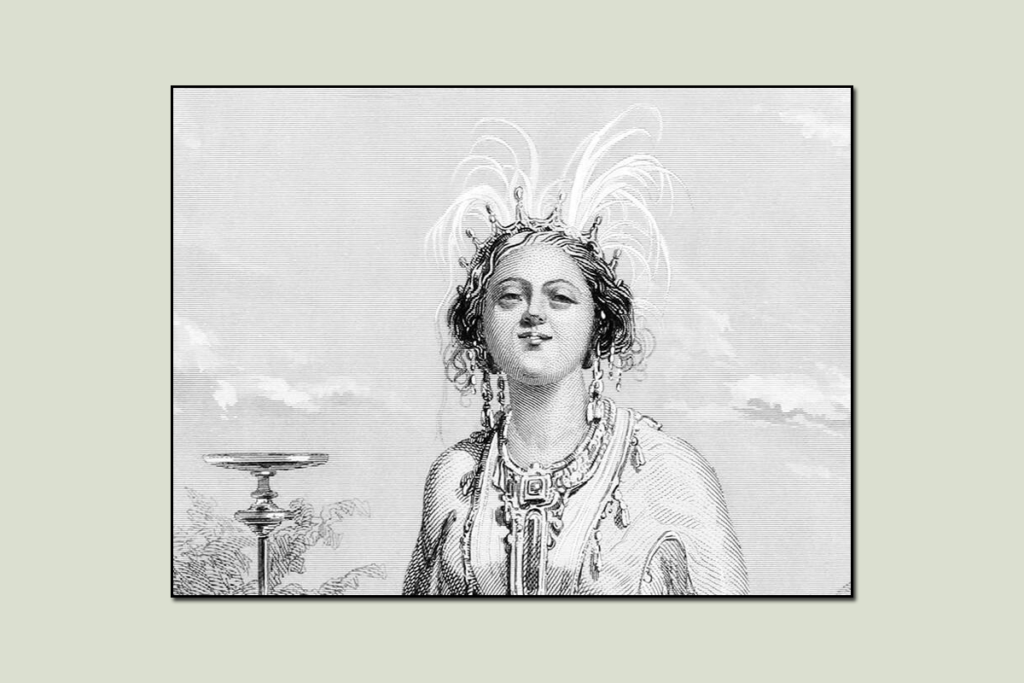
Every village, no matter the size, has Movers and Shakers, the people who lead directly or indirectly. They are respected or feared by the villagers. The Campaign Builder Workbook has you detail 4 specific NPCs which the PCs can interact with. Obviously there should be many more than 4, but this workbook is about providing the bare bones of information to help you get started. In the village section of the workbook, you will fill in more information regarding each of these NPCs which will include identifying other NPCs who are their rivals and allies. By the end, you will have identified 12 NPCs for the village. Now think that some of these NPCs have families, a spouse, children, siblings, and parents which will further help fill out your village.
Village Leader
Whether elected, appointed, or birthed into the role, the village leader is the person with the authority to enact policy. I know using “policy” in this sort of way makes it seem very political science, but in D&D terms this is the person everyone sees as responsible for the safety of the community, the prosperity of the community, and the person who has to solve all the big problems of the community. Even in a No Government village, there will be the person who has the big ideas they are always bringing to the community or the person the community relies on to negotiate freight rates to carry their goods to market.
Most Powerful NPC in the village
This could be the village leader, but village leaders often rely upon more powerful people to bolster their position. The most powerful NPC could be physically the most powerful or is in charge of a large faction of people. This could be the owner of the main industry so has a lot of economic clout. For my part, I like the idea of the person who is asked to get stuff down and then having other people with the resources to get it down. It is a natural balance of power.
Most Influential NPC in the village
The most influential NPC does not have to be a different person than the leader or the most powerful NPC. This is the person whose opinion holds a lot of sway with the other villagers. This could be the wise old woman who knits in a rocking chair while sharing bits of wisdom or the stalwart farmer whom everyone turns to when things go awry. The head of the local temple might have considerable sway over how the villagers behave and react to events.
Most Knowledgeable NPC in the village
Every village has the person who just seems to know a lot about everything. Maybe this is a person educated elsewhere before coming to the village. This person knows about history, arcana, theology, and other information learned from books and study.
Making these NPCs all part of the leadership of the village removes lines of conflict. It is better if they are scattered throughout the village so the PCs are exposed to more areas of the villages, more points-of-view, not just from leadership but from those who are led.
Points of Adventure Near the Village
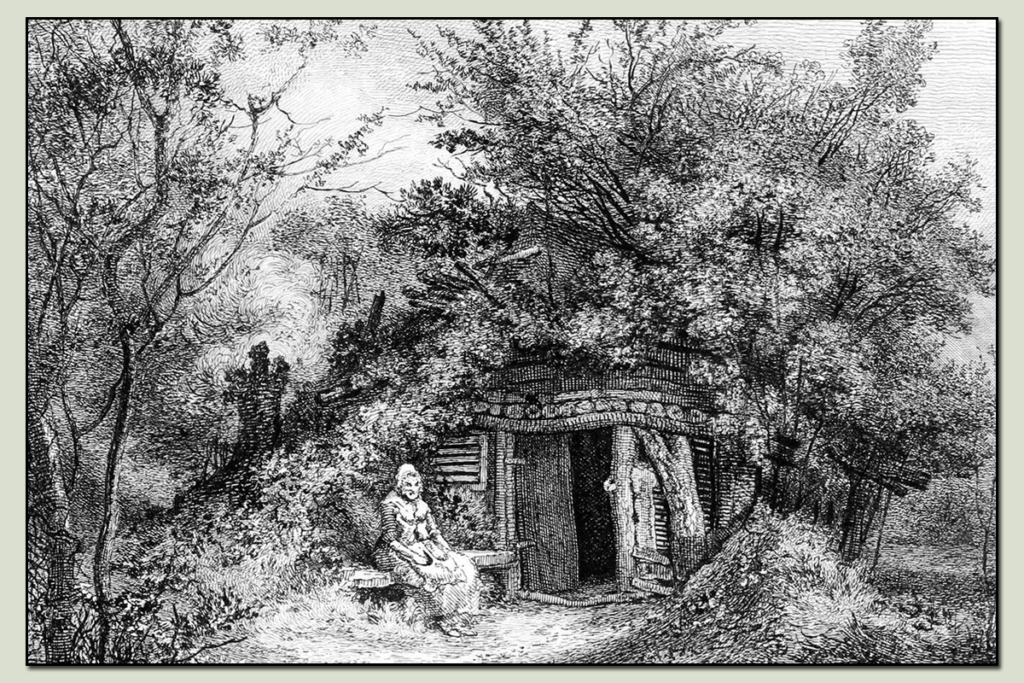
Near the village, but not close to the village, are points of adventure. These are spots that can be explored, stumbled upon, or known through word-of-mouth where something of value can be discovered. The value can be very abstract, like security for the village. The value can be something to help the village achieve a goal. The value can be treasure.
What is included in the Campaign Builder Workbook are suggestions taken from adventures I’ve written and run. Feel free to slot in your own ideas. The workbook asks you to select 3 points of interest. You don’t need to do more than select 3 places where you can run an adventure.
- Abandoned Mine – What was mined here? Why was it abandoned? What is here now?
- Ancient Crypt – Who was buried here? Why were they buried at this location?
- Ancient Ruins – An ancient town or fort? What lost treasures might exist here?
- Bandit Camp – Hidden in the forest or in the mountains? Who leads these bandits?
- Caverns – Who might be using these caves as shelter? Do these caverns lead someplace?
- Corrupted Temple – What corrupted the temple? Who worships there now?
- Dangerous Forest – A wilderness filled with predators or a wilderness filled with the spirits of a slaughtered army?
- Desolated Mill – Why has the mill fallen into disrepair? Why has the village given up on it? Can it be restored and what would that mean to life in the village?
- Druid Grove – In the deep forest or close enough to affect the village? What is the agenda of those who worship there and what affect will it have on the lives of the villagers?
- Fey Circle – a portal to the lands of the fey or a source of mysterious disturbances?
- Goblin War Party Camp – potential trading partners or a threat to the lives in the village — or both?
- Hag Hut – Friend to the village or a threat?
- Haunted Mansion – A grand house filled with the spirits of the old owners or grand house now filled with pests?
- Kobold Camp – a nasty threat to the village, messengers from a nearby dragon, or lost refugees of a far-off war?
- Nomadic Barbarian Camp – Pillagers and raiders looking for food and resources to carry back to their clan or the original inhabitants of the land now trying to survive between the cracks of a growing kingdom.
- Orc Raider Camp – A threat to the territory, emissaries or a greater power, or pursuers of a bigger threat?
- Ruined Stone Bridge – Where did the bridge lead? Was this a vital link to another part of the kingdom? What lives at the bridge now?
- Wizard Tower – Who is this wizard? Why has the wizard built a tower far from the resources a wizard would normally need to do powerful magic?
The Region
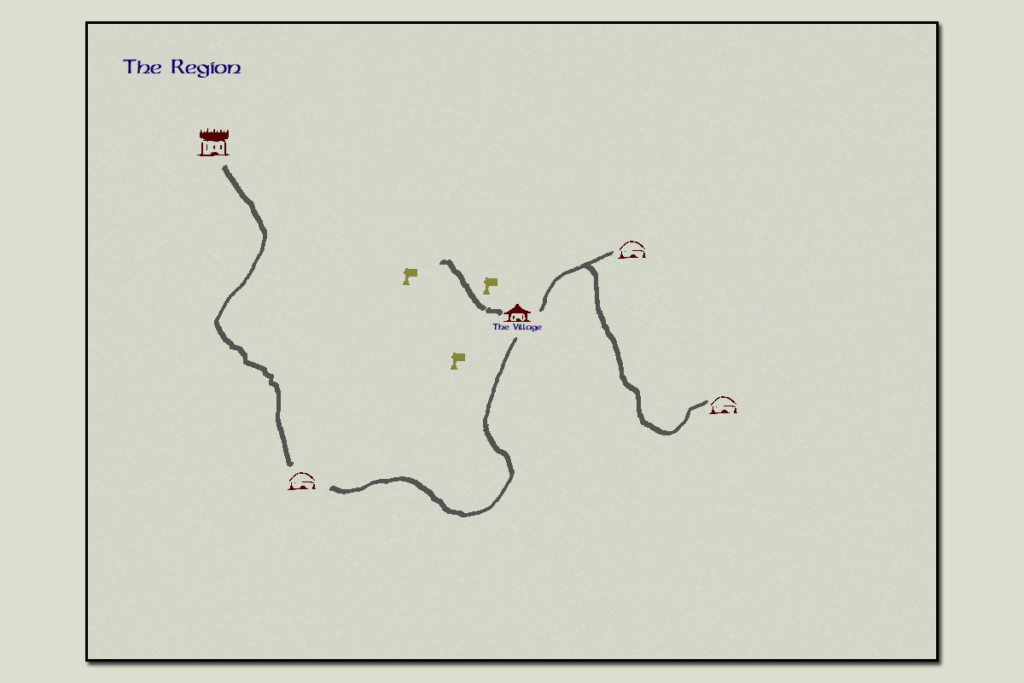
Using Local to Global means slowly expanding outward from the village. So once we have the basics of the village outlined, we need to start laying the groundwork for the region around the village.
Regions can be political or geographical, though geographic regions tend to become political regions as the boundaries make convenient borders.
Name of the region the village is located in?
Now you are giving a name to a large landmass as big as a state or province or as small as a county or parish. It might encompass an entire valley like the Shenandoah Valley or a bay area like the San Francisco Bay. Just keep in mind that you will probably want a few regions in your country/kingdom so don’t go wild. If you want a country PCs can criss-cross in a reasonable amount of time you don’t want to create a region like The Great Northern Plains.
This is another point where you can start thinking about the map of your land. Do you want sea adventures? Do you want the feeling of the wild west with no law beyond the mightiest sword? Maybe you want to play out some survival aspects of adventuring and putting the PCs in a challenging environment to start sounds like a blast.
Type of Region
Here are some examples of political and geographic regions to start.
- District – A political section of land usually part of an Empire.
- Fiefdom – Standard feudal construct, a barony or region controlled by a noble.
- March – A political section of land that lays along the edge of a kingdom or country.
- County – A well-developed political section of land more closely controlled by the monarch/country leader, though directly ruled through vassals.
- Valley – A region between two mountain ranges.
- Plateau – An area well above sea level that is relatively flat.
- Bay – An area surrounding a significant amount of sea that pushes inward.
- Forest – A large section of wooded territory.
- Plain – An expanse of flat grassland.
- Mountain Range – A long section of mountains.
- Foothills – An area near a mountain range of smaller rounded hills.
- Wetlands – A flat area usually near a large body of water where the land is saturated with water creating pools of water of differing depths.
- Desert – An arid expanse of land that gets very little rainfall. It does not need to be hot or sandy.
NPC who controls the Region
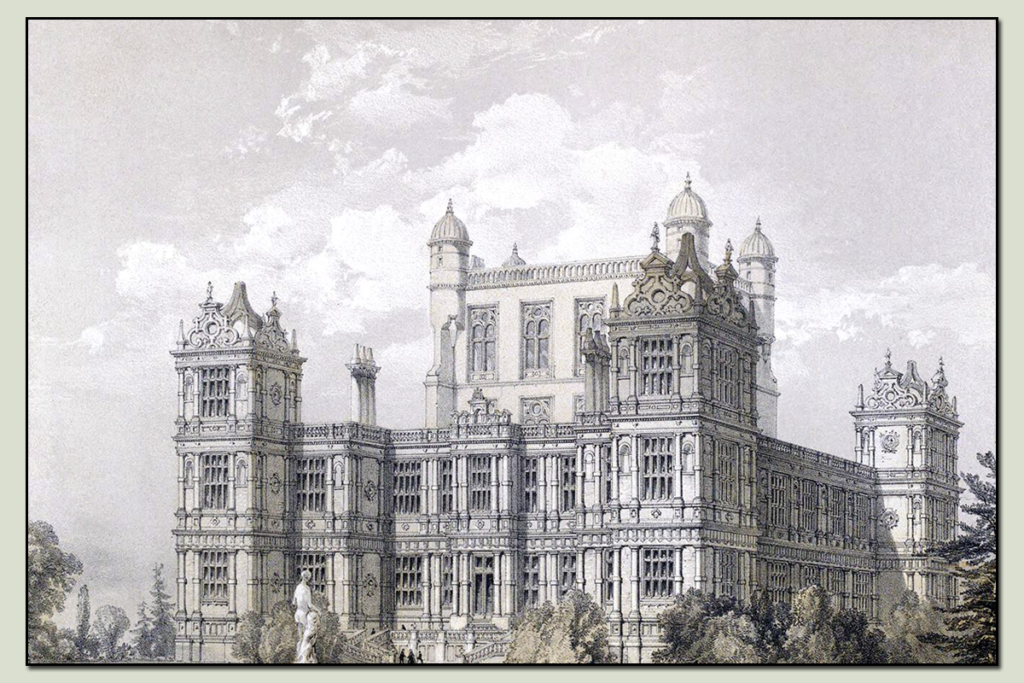
The one rule of life is there is always someone in charge. This can be a Baron, a Duke, or some other noble title. It might be an appointed sheriff. The Mongols appointed Darughachi to administer and tax provinces. This role is essentially a governor to the village’s mayor. Someone with greater authority, potentially more resources, and bigger issues to worry about on a day to day basis than the random events that occur in a village.
Most powerful NPC in Region
At this level, powerful isn’t just the guy who can rally the most people in a fight or can spend the most money to get his way. Powerful on a regional level means this person can raise an army of trained soldiers, can hire the best mages, has access to arcane knowledge, and is feared.
Most influential NPC in the Region
On a regional level, influence is more than having sway with villagers. Influence means powerful people listen to this person. This person can walk into any town, any village in the area and be immediately recognized. This person is a minor celebrity. They could be bards or royal advisors. They could be inventors or great healers.
Most knowledgeable NPC in the Region
Wise and respected, this person might run a school like Plato’s Lyceum or could be seen as a keeper of a valued library like Zenodotus of Ephesus at the Great Library of Alexandria.
Most immediate concern of the Region
What is the leader of the region working on right now? Collecting taxes? Fending off bandits? Negotiating a trade deal? Something is occupying the leader and the leader’s agents right now. It can be benign like taking a census or nefarious like tracking down the first born son of every family in his demesne. This is the opportunity to think in terms of political weddings, feasts, festivals, and fairs.
The region could also be occupied by a military force. During the Hundred Years war, England occupied areas of France and didn’t necessarily disturb the small villages. An earthquake could have destroyed bridges and roads, collapsed temples and fortifications which is now taking time, money, and energy to fix.
This issue can tie into the events around the village (makes for a good transition from village level events to regional events) but doesn’t have to be. You are building a story. Not every thread detailed in the workbook needs to be attached to the tapestry of the story, in fact not all should be, but by weaving them together, you will create a deeper story that can sustain an entire campaign. Besides, players love finding out that the small thing they did in the first adventure ties into bigger plots and can become obsessed over loose-ends.
Long term goal of the Region
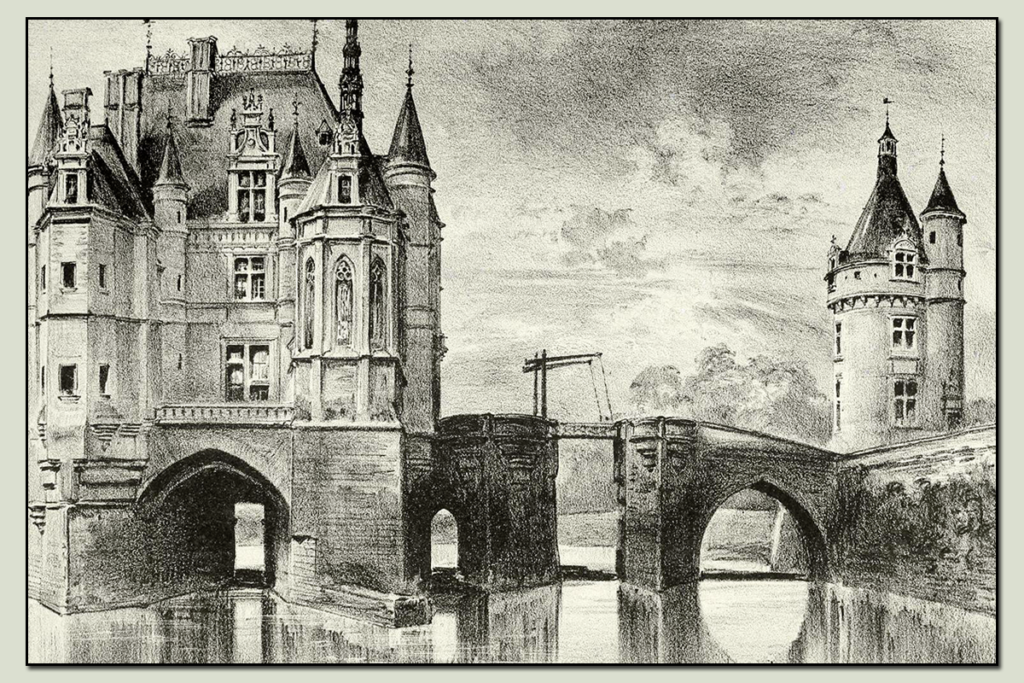
The leaders of the region have an agenda. In five years or in a generation what would they like to see accomplished? It is okay to be a bit abstract with this goal. You are only using this to help provide motives to random NPCs. They can be working to achieve this goal or to oppose it. They may get something if the goal is achieved or lose something.
A region can have multiple goals so if you have ideas for a few, go ahead and list them all. I generally like to keep it focused on the most important goal and attempt to tie it into the greater theme of the campaign.
Some simple suggestions for regional goals include gaining prominence in the kingdom, becoming the source of currency for the kingdom, rebellion, banning all infernal magic, stamping out all worship of a god, ending slavery, expanding slavery, or starting a mine for a special mineral. I tend to be pragmatic, but don’t let my lack of far-fetched ideas impede you. And just because it is the goal of the region doesn’t mean everyone in the region is onboard with it.
Keep in mind this goal should relate to the region as a whole, not the regional leader. So the regional leader can be a villainous person wanting to bathe in the blood of maidens every full moon, but the goal of the region might be more along the lines of ending peasant unrest, stopping raids by barbarians, or building fortresses along the border to protect against the ancient black dragon Gtharian the Putrid and his kobold armies.
Points of Adventure in the Region
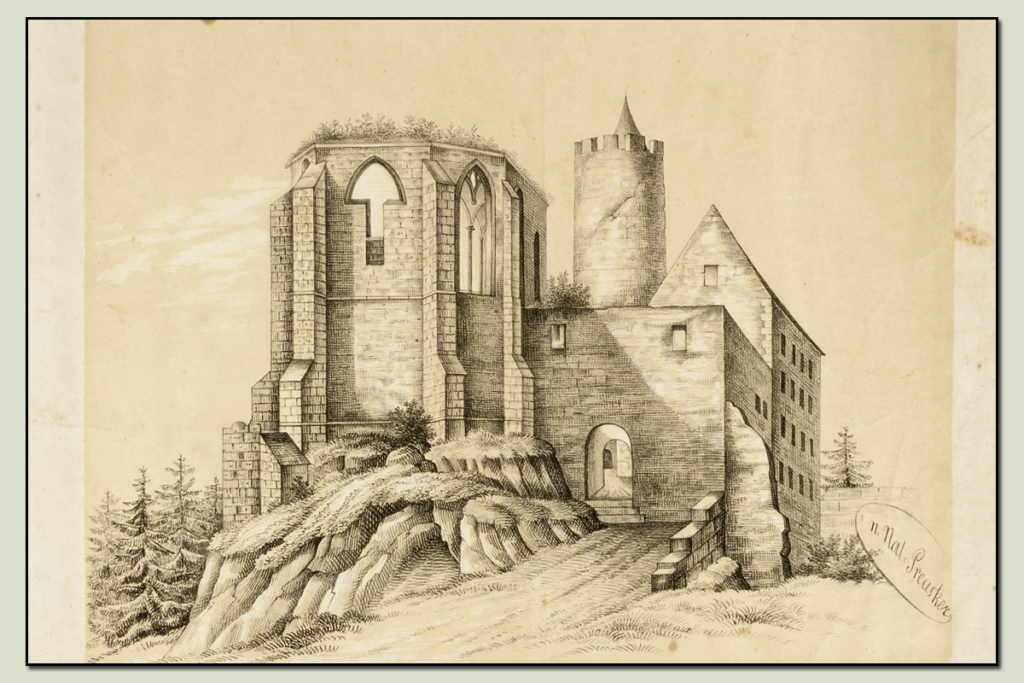
These are geographic areas and places to be explored, stumbled upon, or known through word-of-mouth where something of value can be discovered. These can relate to the immediate concerns of the region, be of concern to the PCs, or just be something interesting to investigate.
What is included in the Campaign Builder Workbook are suggestions taken from adventures I’ve written and run. Feel free to slot in your own ideas. The workbook asks you to select 3 points of interest. You don’t need to do more than select 3 places where you can run an adventure.
This is another opportunity to start to think about the geography of the region. The starting village may be inland, but the region itself may have a coastline. The village could be near more civilized areas but the region may border an unexplored wilderness, badlands, or an infernal field of fire.
- Abandoned Fortress – Ancient or modern? Why was it abandoned?
- Abandoned Village – What caused the villagers to leave this village? Was it quickly or over a generation?
- Ancient Crypt – What was buried here and why was this location chosen as the burial site?
- Ancient Ruins – What was once here? What lead to its destruction?
- Caverns – What could live in these caves and why is it now a concern to the region?
- Cursed Village – What has cursed this village? What keeps the villagers there?
- Dangerous Swamp – Swamps are a geographic nuisance filled with dangers, but why is this particularly dangerous to the region?
- Desolate Lighthouse – Why has the lighthouse fallen into disrepair? Can it be restored? What will that mean for the region?
- Dragon Den – What dragon lives here? What does the dragon want? What threat does the dragon pose to the region?
- Dungeon – a Tomb of Horror? A Temple of Elemental Evil?
- Hag Hut – Does this hag have an agenda or does she want to be left alone? Does she hold a secret that must be revealed to save the region?
- Haunted Castle – What haunts this castle?
- Hobgoblin Camp – A camp of savage warriors bringing chaos to the region, a military invasion of the region, or a frontier outpost to keep the region’s military force in check?
- Monastery – Why have these monks secluded themselves? What secrets do they hide?
- Monster Habitat – Owlbears? Chimera? Medusa?
- Shipwreck – The remains of a tradeship? The hull of a military vessel? The last pieces of a pirate ship? What treasures does it contain?
- Temple – A lost temple? A forgotten temple? A temple to a new god?
- Thieves’ HQ – Who are these thieves and what thievery do they plan?
The Country
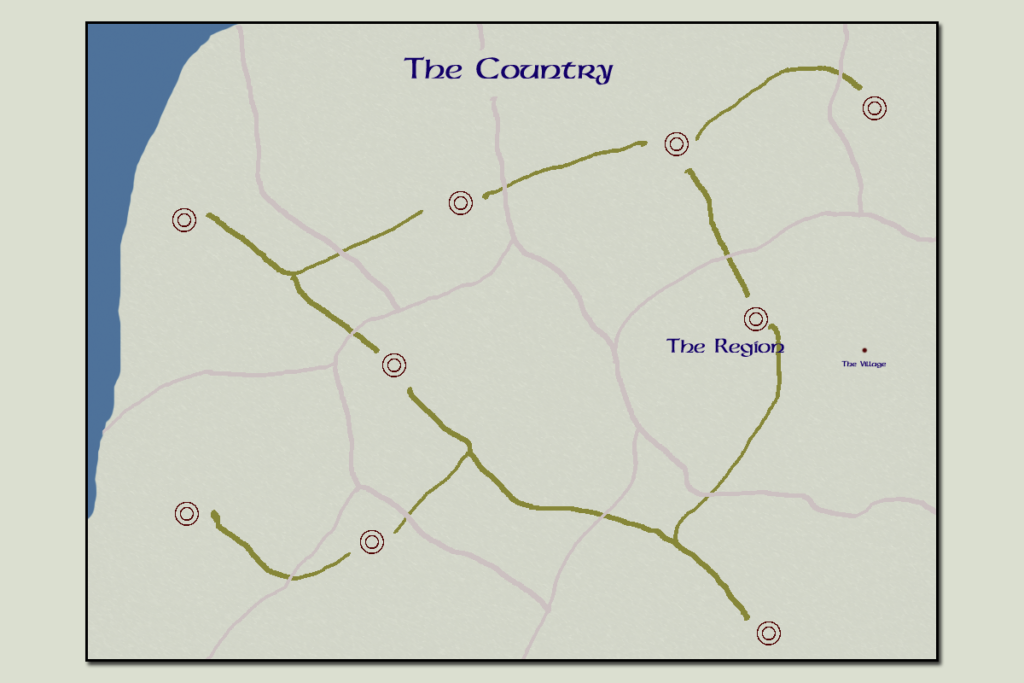
Name of the Country the region and village are in?
Now is the time to pull out all the creative stops. Your starting village can have a quaint little name: Bluebell, Stars Hollow. The region can hint towards prominent culture or the location like the Stormlands, or The Shire.
The country’s name means something more. It must be evocative but not on the nose. Ansalon of Dragonlance, Skyrim and Morrowind of the Elder Scrolls games, The Dwendalian Empire, Xorhas, and Menagerie Coast of Matt Mercer’s Wildemount.
Type of Country
This is admittedly very loose in definition. Ideally you want to have an idea of how the country is ruled. These are six primary governing structures which you can use as a base to fashion a political structure for your campaign.
The limitation of the Campaign Builder Workbook is it isn’t a world building workbook. There are other resources to help you flesh out a full working government structure for the lands of your campaign world.
For the most part, unless my players are really into political machinations, I avoid getting into the details of how the government is run. Just knowing if it is kingdom with a monarch, an empire with an Imperial leader, or a republic populated by senators is all I need. The government can also be a hybrid, like an imperial republic, which is essentially what Rome was or a Constitutional Monarchy like England after the Magna Carta.
These are all traditional European/Asian constructs of government. Whether you are replicating the Holy Roman Empire, the Han Dynasty, the Mongol Empire, the Rashtrakuta Dynasty, or the Khmer.
- Feudal Monarchy – Usually an inherited seat of power with a complex structure of lines of successions and oaths of fealty. These are the standard European kingdoms we are accustomed to reading about in European history.
- City-State – A more rare form of government, City-States made up most of pre-Italy Italian peninsula. Large powerful cities with little direct control of land beyond their borders.
- Sovereign Principality – These are smaller kingdoms, ruled by a noble sometimes in the line of succession of a greater kingdom or sometimes appointed by powerful nobles. Monaco is an example of an existing Sovereign Principality.
- Empire – Pharoahonic Egypt, Ghengis Khan’s empire, Alexander the Great’s empire, the Roman Empire, the Byzantine Empire, are all historical examples to draw inspiration from.
- Republic – Not common historically or even in fantasy literature, republics/democracies are countries led by elected officials. You can look back to ancient Rome or Greece for examples.
- Theocracy – A government led by a religion. There are many ways in which this can be pieced together under the guise of other governmental structures. Consider Spain under Ferdinand II of Aragon who established the Tribunal of the Holy Office of the Inquisition to enforce religious law.
Name of the ruler of Country
Who leads the country? The name will be made fun of, no matter how hard you try, so don’t dwell too much on this. Keep it memorable and unique though so it doesn’t get lost in the mix of other NPCs. I like adding a nickname or some other element to the nomenclature, like Monarch Gabrielle the Learned or Imperial Viscount Hammon Veritoth IV. Those examples are just that, examples. It is your campaign world, your NPC. Name them as you wish.
Name of the biggest rival of Country
Every country has a rival. Elizabethan England had Spain (and France). Ancient Rome had Carthage (and many others). The rivals don’t necessarily have to be a political threat. It could be rivals in exploration or invention.
Every country compares itself to other countries in one way or another. The rival doesn’t even have to be a full-fledged country but could be something like the leaders of peasant revolts or religious leaders trying to reform church doctrine. The rival even could be a resurrected evil from the dawn of time who is slowly corrupting the land and the people in order to seek revenge against the Council of Three who banished it to a nether region of the abyss masquerading as an Elven farmer.
Most immediate concern of Country
A military build-up on the border, the death of a leader, lost trade routes, missing colonies, broken treaties, or a necromantic cult creating chaos in the land are all country level concerns.
Like before, this is something the leaders of the country are working on right now, at the start of your campaign. It could be the initial phase of a bigger campaign plot or it could be background noise to provide context for NPC actions.
Greatest threat to peace in Country:
This entry is a bit more nebulous. This does not have to be something anyone in the country knows about. It could be the hidden cabal plotting a coup or a the Liche gathering forces to open a portal for the forces of Orcus to invade the realm. Maybe it is a famine in a neighboring nation which will trigger a surge of refugees.
Consider this element to be part of the greater campaign goal or turn it into a triggering event for the campaign. In my campaign worlds I’ve used an attempted coup and invasion by foreign nations to push the PCs into the main groove of the campaign plot.
Disrupting the peace is the best way to motivate PCs. Even chaotic and evil PCs don’t like it when others are creating chaos and evil.
Point of Adventure in the Country
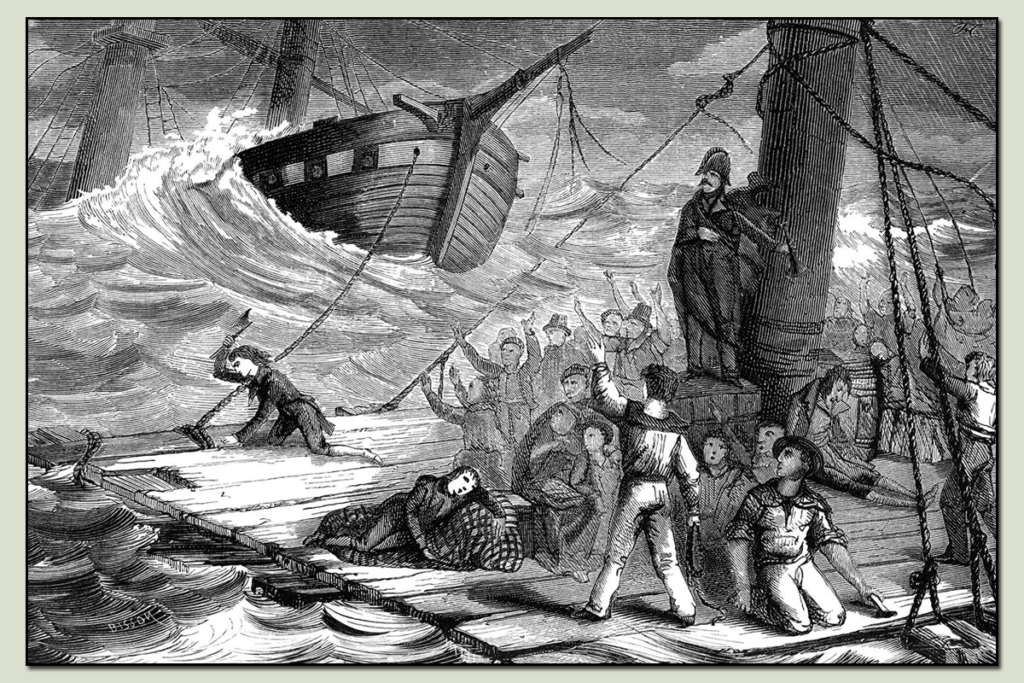
Yet another opportunity for you to think about the geography of the land. Where are the ancient ruins and why are they there? Shipwrecks, dying forests, and mysterious glows all need to be placed on a map somewhere.
As in the other sections, these are starting points. Little seeds you can use to tickle your own imagination. At this level, don’t worry about putting a pin on a map. These points of adventure can be wider areas. Entire villages or areas of mysteries can be the point.
- Abandoned Fortress – Ancient or modern? What drove the occupants away?
- Abandoned Village – Ancient or modern? What drove the villagers away?
- Ancient Ruins – What was once here and what destroyed it?
- Caverns – What lives in these caverns and why is it a concern for the country?
- Cursed Temple – Why was this temple cursed and what affect does that have on the country?
- Cursed Village – Who cursed this village and why?
- Disappearing Ships – What is causing ships to disappear?
- Dragon Den – What dragon lives here and what does the dragon want?
- Dungeon – A White Plume Mountain or a Shrine of Bundushatur?
- Dying Forest – What is killing this forest?
- Foreign Military Camp – Why has a foreign military set up an outpost so close to the border?
- Giant Camp – Who are these giants and why have they migrated into the country?
- Haunted Castle – What haunts this castle? Is this castle needed by the country for defense?
- Monastery – Do these hermits have knowledge needed by the country in a time of crisis? Are these monks secretly controlling a cabal to thwart or enact some prophecy?
- Monster Habitat – Home of a fabled unicorn or phoenix or maybe a pit of unspeakable horrors.
- Mysterious Glow – Why is that mountain glowing?
- Shipwreck – Was this ship carrying the proof of a conspiracy or was it the ransom for the monarch’s child?
- Temple – Why is this temple significant to the fate of the country? Does something need to be brought to the temple as part of a periodic offering or has this temple brought forth a message from a god that needs to be heard by all in the country?
The Continental Area

The country is located within a bigger area. None of these really plays a role within the campaign unless you want it to. This is just the final bit of information you need to help provide geographic context to everything you put together in the survey.
If you want to build out the Continental Area in the same way as the village, region, and country you can. Continental areas do not have a single ruler, for the most part, unless it is an empire that has conquered the entire area. Think Alexander the Great’s empire stretching from Europe and North Africa to India. It is possible to have a campaign setting with a country that owes fealty to some greater power. The Mongols held sway over much of central Asia and extended their influence and power into Europe, but most of those countries were left alone so long as they paid their tribute.
Name of the Continent/Sub-Continent
This can be your entire world, like Discworld or Narnia, or it can be one part of your bigger world like Faerun, Oerik, or Wildemount. By now you get the point. No matter what you name your continent some wise-acre of a player will corrupt it. So go ahead and call it Hartgreller knowing it will be transformed into fartsmeller at some point.
Largest political power in area
This could be your starting country or some other entity. If it isn’t the kingdom you are starting your campaign in, then you will want to understand how your starting country relates to this power.
Second largest political power in area
This could be your starting country or some other entity. This will get repetitive.
Third largest political power in area
I think you know what is going to be said here. This could be your starting country or some other entity.
Largest military power in area
This could be your starting country or some other entity. If it isn’t the kingdom you are starting your campaign in, then you will want to understand how your starting country relates to this power.
Second largest political power in area
This could be your starting country or some other entity. Why three in each category?
Third largest political power in area
This could be your starting country or some other entity. Well, a balance of power between two gets boring. There are no red herrings. When there is only Florin and Guilder then the lines of conflict are directly against each other, but toss in a third entity and now there is mystery and choices to be made.
Richest power in area
This could be your starting country or some other entity. If it isn’t the kingdom you are starting your campaign in, then you will want to understand how your starting country relates to this power.
Second richest political power in area
This could be your starting country or some other entity.
Third richest political power in area
This could be your starting country or some other entity.
Even if there are more than 3 countries, it is best to focus on the top 3. You can also fit another small nation in between the cracks. Think Europe… dominated by England, Spain, and France but that doesn’t mean there isn’t a Portugal, Netherlands, Ireland, or Scotland. Starting with the most powerful entities gives yourself room to fill in the cracks with other powers and entities as you need. It is harder to suddenly create a massive military armada no one has ever heard of then having a few NPCs from a small country.
Village Details

You’ve just finished the Campaign Survey and that is a lot of information. Just remember that filling out the survey does not mean you cannot change any of the information as you proceed.
In the Village section of the Campaign Builder Workbook, you start developing some of the details. Not all of them are critical, but they start to let you flesh out the bones a bit. Also remember, everything here is a seed, a starting point, a quick sketch which you can use or ignore as you see fit to put together the kinds of adventures you want.
Village Leader
How did the Village Leader become the village leader?
Knowing how someone was put in charge tells you a lot about them. Were they ambitious and craving the power? Was it thrust upon them?
Who is Village Leader’s biggest rival/nemesis?
Don’t think of a rival or nemesis as a villainous person. This could just be someone who would rather be in charge or someone who is opposed to a policy.
Who is Village Leader’s biggest ally/friend?
This person is the person the village leader turns to for support and advice.
What is Village Leader’s most notable physical trait?
As the campaign develops, you need to start thinking about who the NPCs are. Is the village leader old, young, fat, thin, short, tall, weird hair, or bald?
What is Village Leader’s most notable personality trait?
Beyond the physical trait, knowing the key personality trait will help further develop the NPC. Kind, curious, absent-minded, or focused?
What does the Village Leader want to accomplish as village leader in the near future and beyond?
Starting to think about the NPC as having multiple motives will deepen the NPCs personality. Having a child who is in a bad marriage might be a distraction. Family motives are good alternate motivations because they aren’t always obvious. Don’t make the mistake of tying this too closely to any plot. It is okay to have loose threads and a bit of messiness, especially in the beginning.
How is the Village Leader handling the natural threat?
In the survey a natural threat was defined. What is the village leader doing about it? Ignoring it? Organizing skilled laborers to take care of it?
How is the Village Leader handling the political threat?
In the survey a political threat was defined. What is the village leader doing about it? Ignoring it? Negotiating with different factions?
How is the Village Leader handling the martial threat?
In the survey a martial threat was defined. What is the village leader doing about it? Ignoring it? Recruiting mercenaries to protect the town?
The Other Notable NPCs in the Village

Each of the other NPCs called out in the Campaign Survey have the same rundown as the village leader.
There is a section on this page that gives some suggestions for the maximum level of clerics, magic-users, fighters, and rogues in the village. Small villages and towns usually share a religious figure who travels between them. Magic-users need access to specialized supplies that aren’t commonly found near and around small villages. A rogue needs targets to rob and a backwater village doesn’t have much to steal. This is a suggestion and just helps you figure out who is in your village. Does this mean you can’t have a 20th level wizard in your tiny village? Nope, you totally can. You’d just want to think about why that wizard, warlock, sorcerer is there. Did they bring along enough pieces of adamantine worth 500 gp in order to cast Invulnerability more than once? Casting a Glyph of Warding uses a 200 gp diamond.
Just having this stuff stored in his home/workshop makes him a huge target for thieves. Of course, at a certain point, Going remote is one of the best ways to stop the constant attempts at theft. People not familiar with magic might not realize that bag in that chest is a pocket dimension holding 20 feet by 20 feet by 20 feet of gemstones to be used in casting spells.
Structure of the Village
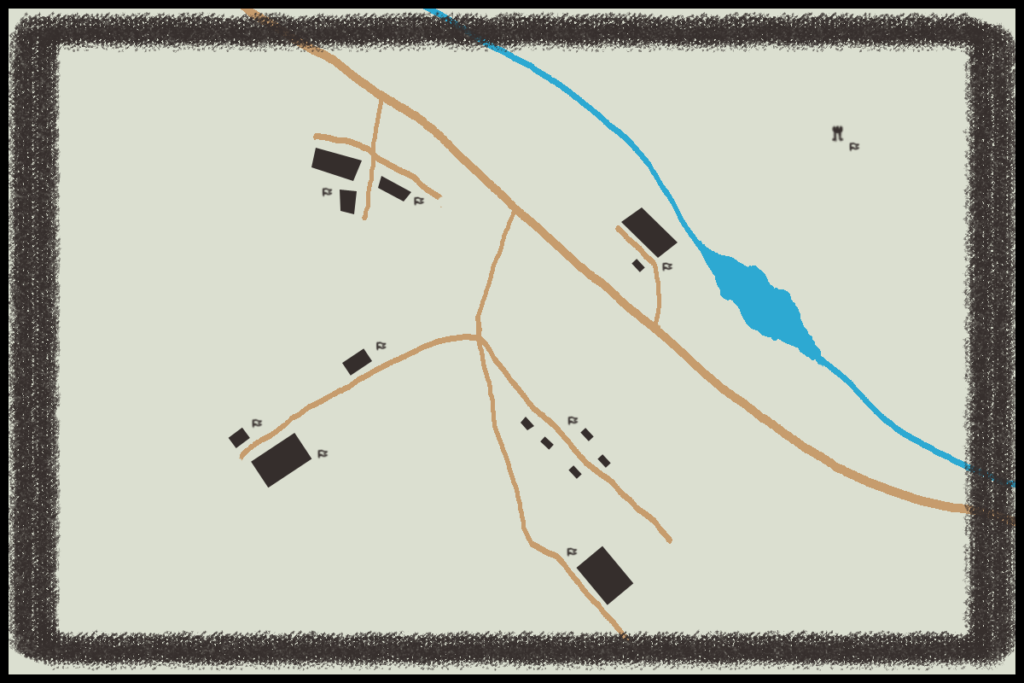
When I first started building campaigns, I’d think about this building or that building in the town, but I found that it was creating cookie cutter villages. Seriously, I’d say “here is the Inn, here is the temple, here is the Mayory’s house” and so on. So I started thinking about the functions a village needs.
I won’t lie, I was motivated to change my methodology by watching Little House on the Prairie. Walnut Grove is a tiny village and has a school that acts as the church. They built a bank, have a mill for grinding grain to flour that is also is a sawmill when harvest isn’t happening. There is only one store and much of the commerce is based on trade and barter.
Now the method talks about what the village needs and how those needs are met which let’s me think a bit outside of the box at times. Now instead of there always being an inn and tavern, sometimes it is old Duren Brassthumb’s home where he serves up his special maple and honey liquor for those craving some spirits and if they need a place to stay, the Shrine of St. Cuthbert let’s people sleep in the main hall after dark.
- Where does the community get food?
- Where does the community get fresh water?
- Where does the community get supplies?
- Where do most of the people in the community work?
- What is the most prominent feature of the village?
- What is the oldest feature of the village?
- Where does the community gather to discuss issues?
- Where does the community gather for entertainment?
- Where does the community practice the primary religion of the area?
- Where do visitors to the community stay?
- Where would a visiting noble stay if they came to the village?
- Where would the community go if threatened by a military force?
- Where do ne’er-do-wells gather?
- Where does the village bury their dead?
- Where does the main road in and out of the village lead?
- What is the nearest town larger than the village?
- What is the nearest city to the village?
The Culture of the Village
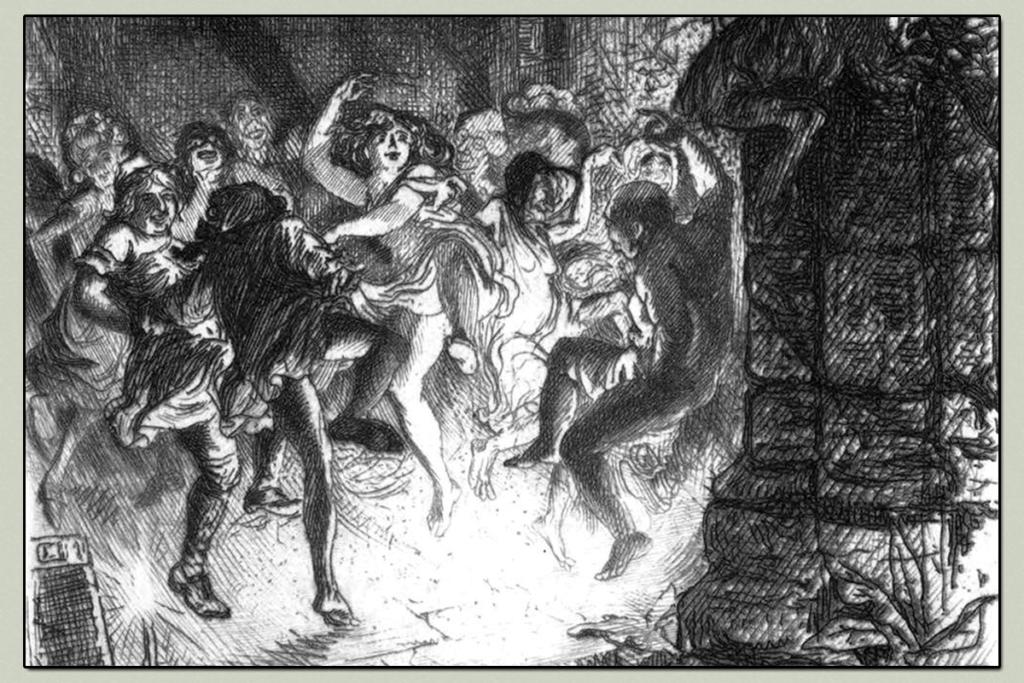
Here are some important details. Is this a village of all one people, all humans or elves, is it mixed? How mixed? How do the villagers react to outsiders? An adventuring party might be composed of Half-Orcs, Kenku, Tabaxi, Dwarves, or any other playable folk. Are Tieflings accepted by everyone or are they seen as bad luck, cursed people? You need to know this to prepare for whatever your players throw at you.
When a player chooses one of the newer folk in D&D – the Genasi, Tabaxi, Kenku, and so on, I try to get a sense of what they are looking for in the choice. If they want to play out the social issues, then I know to edge my villagers into not liking and accepting the PC. Maybe certain villagers won’t do business with them. My one word of caution is roleplaying racism will make you feel gross, so proceed with caution and only if the player is interested in playing out these themes. Most of the time players choose a type of folk to play because they like the abilities and aren’t thinking about negative aspects. They see D&D like a bar in Star Wars, filled with interesting and wild people and no one is singling them out in a racist sort of way (unless they are droids). So in this case, even if your campaign relies upon people seeing Dragonborn as some sort of evil, this particular village doesn’t for some reason.
A starting village does not mean all the PCs come from this village. There will need to be a reason why the PCs are here, but that reason can be figured out in a session 0 and ideally a prompt for the first adventure.
- Who are the primary people of the village? Is this a human village, dwarven, elven, halfling?
- What is the primary religion of the village? What god do most of the people worship in this village?
- What story do villagers like to tell the most? Did the monarch once visit to hunt in the nearby woods or did a dragon once descend upon the village and was fought off by a local hero?
- What are the villagers most proud of? Did the village once contribute soldiers to a cause and these soldiers were part of an important battle? Maybe this village makes the best beer in the kingdom.
- What are the villagers most ashamed of? Home of a traitor or hiding a curse?
- What major festivals and holidays does the village celebrate? Are there harvest festivals, days of feasting or fasting?
- How do the villagers feel about outsiders/unfamiliar people? Is this a welcoming village or a closed off tightknit village?
- What do the villagers eat on a daily basis? Soups, stews, roasted meats, bread, or gruel, the daily diet says a lot about how the village spends its time and the level of its resources.
- What do the villagers drink on a daily basis? Water, beer, wine… what the village drinks is important. Does the cleric purify water or is there a fresh spring supplying the village with drinkable water?
- What do the villagers eat/drink on special occasions? Knowing what the special feast foods are will help you create those memorable scenes.
Village History

The past is prelude. You need to have a sense of what happened before to understand what is happening now. This is divided into two sections: recent history and ancient history.
These events should have a relation to one of the threats facing the village, but it doesn’t have to. Tying those things together just makes for a more complete story.
The Recent History
What event had the most profound effect on the village?
Who was affected by this event?
What are the lasting effects of this event?
Ancient History
What was here before the village?
Most notable event in or near the village?
What are the signs of this event still experienced by the people and/or land?
Village Adventure Hooks

There are three sections that helps you start fleshing out the details about the Adventure Hooks for the village. There is a tab just to help you flesh out the adventure and encounters so you don’t have to worry about getting in-depth. These questions really are about the village’s relationship with those spots.
- Why has no one visited this location recently?
- Why would someone visit this location now?
- What is there to challenge an adventurer?
- What is there to reward an adventurer?
- Who in the village knows about this location?
- What are the geographic obstacles to get to this location?
- What are the dangers of traveling to this location?
Region Details

Key Settlements
Here we want to expand on the details of the region. We start by identifying what other villages are nearby. There is an additional detail included here. You want to indicate how many days walking it takes to get from the village (settlement 1) to the others.
A person can walk 30 miles in a day (8-hours of walking). These details will help you start building the map of the region. You want at least 1 day’s distance between villages just to keep it inconvenient.
Two villages may be close physically but PCs walking or riding horses need to go around a large geographic obstacle. The thing to remember is each day on the road means spending a night out in the open.
The largest city in the region will usually be a trading center or a political center of some sort. It might be where some of the PCs actually come from.
Region NPCs
Like the village the NPCs need to get more detailed. We are talking physical traits and personality traits. We want to talk about motives and goals.
These questions should be familiar since they are the same as the village NPCs. At this point threads of a story should be coming to you. You should have a sense of how some of these NPCs interact with each other and how their goals interact with the environment you are creating (village threats, adventure hooks, etc.).
Regional History
Like with the village history, you want to figure out what has happened in the region. Don’t just think of political or military type events, think about geographic events (and divine and magical events). Think of some of the people involved in these events and the effects these events have on communities and lands.
Regional Adventure Hooks
Regional adventure hooks have slightly different questions. These spots are meant to be a bit further from settlements of any type so you don’t have to explain why bored kids haven’t stumbled upon them.
- Why has no one visited this location recently?
- Why would someone visit this location now?
- What is there to challenge an adventurer?
- What is there to reward an adventurer?
- Who knows about this location?
- What are the geographic obstacles to get to this location?
- What are the dangers of traveling to this location?
Country Details
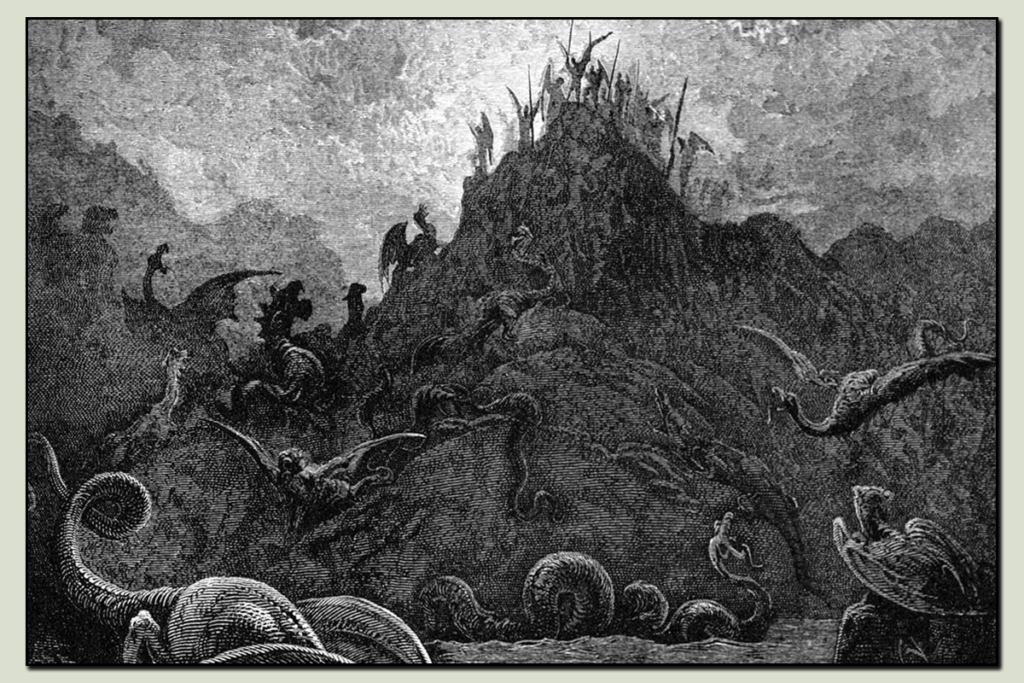
Key Cities
Looking at the country as a whole, you don’t want to waste time building out dozens of villages that will never be visited. But you want to give a sense that the country is significant in size (or not, that is a design choice). I’ve run campaigns with as few as 3 cities and 2 villages. I’ve run campaigns with as few as 1 city.
All this is doing is giving you a skeleton to work with. 5 cities too few, add more. 5 cities too many, don’t put them all down.
This will also detail the distance between the cities. Once again allowing you to sort out the layout of your lands.
NPCs
To start, there really is only one NPC you need to be concerned with. The leader of the country. Of course there are many others who you will want to detail, but until the PCs need to encounter them or until they play a role in an adventure, it is okay to leave them vague.
Country History
Detailing the entire history of the country is daunting. So again we look at the most immediate prominent historical events that have an effect on the PCs or elements of the lands the PCs will interact with.
Country Adventure Hooks
You will be providing more detail on this hooks in the next section but at this level you should also be thinking the PCs are more powerful. These shouldn’t be “kill some rats” type adventure areas. Start thinking in epic heroic terms.
- Why has no one visited this location recently?
- Why would someone visit this location now?
- What is there to challenge an adventurer?
- What is there to reward an adventurer?
- Who knows about this location?
- What are the geographic obstacles to get to this location?
- What are the dangers of traveling to this location?
Plotlines

A plotline only needs to be a sentence explaining why the adventure exists. What is the core challenge? You will also notice these adventures are broken into Tiers. These relate to the DnD5e Tiers of Play (Dungeon Master’s Guide – p.36), but don’t lock yourself into this way of thinking. It is okay to mix things up.
Each adventure hook area should have a brief summary. Maybe you are already planning to run some published adventures and know you will need a Keep on the Borderland near some Caverns. You can just use the published adventure’s setting and setup.
Included in each tier of play is a tie-in summary. These are possible adventures to move the PCs from one tier to the next tier. When I created this Workbook, I thought back on adventures I created that made the players feel like their characters achieved something significant that got them the praise and attention of more powerful figures. These were transitional adventures leading them to take on bigger adventures.
Please don’t think there are only 3-4 adventures at each tier. These are just three adventures you are developing at the start of the campaign so you can weave them together for your players.
What does the ID mean?
Don’t worry about it. I have delusions of grandeur and I like giving ID tags to my adventures with the hopes that I might be able to publish them at some point. I also use online tools to build encounters and I used these ID tags to align the encounters to the adventures I am writing.
Campaign Arc
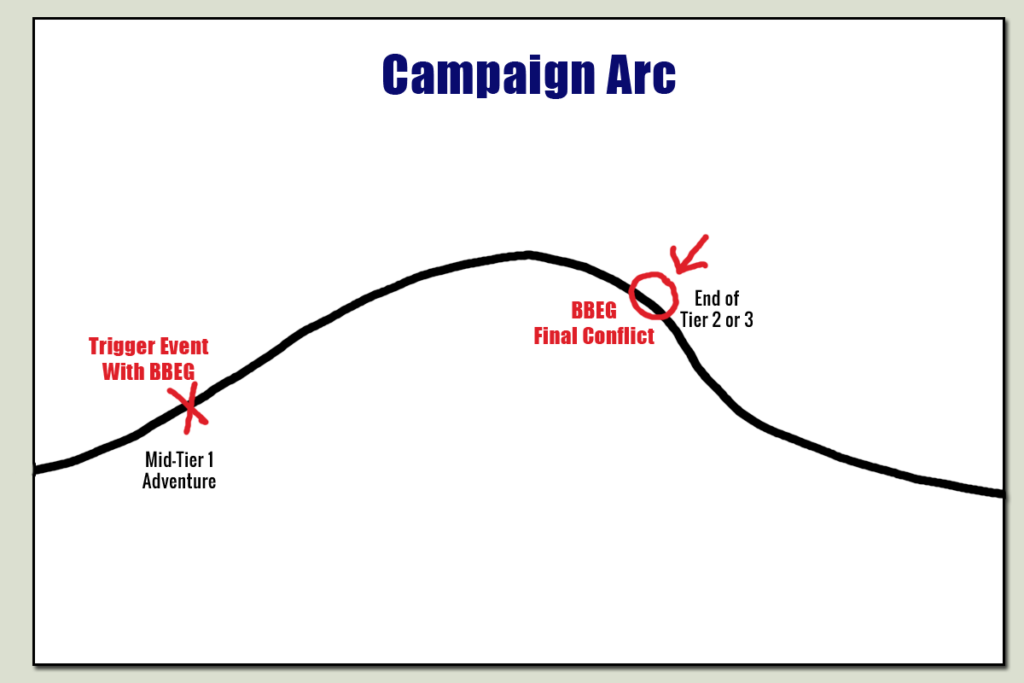
The final element is the campaign arc. A campaign can have several arcs. The workbook helps you get started with just one of them.
Who is the Big Bad?
The Big Bad or Big Bad Evil Guy or Main Antagonist is an easy identifier. This is the entity who has an agenda which disrupts the status quo. This may not be a bad thing, so don’t think of this person as EVIL. In fact it is better if this person has a noble goal that on the surface anyone thinks is good. I say it is “better” but I usually fall back to “High Priest of Evil God” summoning demons as a campaign arc because it is simple, classic, and sometimes the players need a clear “that’s the guy you need to stop” call to action. Indiana Jones fought Nazis. You don’t need any further motivation than that to motivate a player to make their PC take an action.
What does the Big Bad Want?
The Big Bad’s agenda needs to be big enough to warrant assembling powerful PCs to thwart it. So this isn’t a simple desire to build a fortress or kidnap a noble. Yes these can be bad, but normal forces within the country can address those. Think in terms of what will change if the Big Bad gets what they want? You want to think of devastation or a massive disruption to normalcy.
Why does the Big Bad Want this?
The desire to destroy everything is a great agenda but it is sort of suicidal. Motives can be quite complex but as with all things you can begin with a nucleus, a core element and build up around it. (Notice a theme in all of this?)
- Romance – the Big Bad does it for love.
- Revenge – the Big Bad is punishing those who have wronged them.
- Justice – the Big Bad is righting a wrong, poorly.
- Greed – the Big Bad wants to amass wealth (usually there is a reason for the wealth but sometimes a dragon just likes all the shiny things).
- Existential Threat – the Big Bad is driven by a threat to their existence.
- Fate – the Big Bad is driven by fate or prophecy and trying to change a predicted outcome or achieve it.
- Power – the Big Bad wants power over the land, but like greed there is usually something else behind that, a need to change something about the land.
- Hate – the Big Bad has a blinding hate which drives them.
- Rebellion – the Big Bad needs to overthrow the current power structure because the current power structure is unfair or an obstacle to some other goal.
- Savior – the Big Bad believes they are a savior and their actions will have greater benefits in the long run.
- Grief – the Big Bad is driven by sorrow or the fear of sorrow.
- Protection – the Big Bad wants to protect someone or something.
- Isolation – the Big Bad wants to be alone and is looking for a way to achieve that isolation.
- Fear – the Big Bad is afraid of something and is driven to take action to avoid it.
- Narcissistic Pride – the Big Bad believes they are the only one capable.
- Competition – the Big Bad is competing with others for a prize.
What is preventing the Big Bad from accomplishing this?
Knowing why the Big Bad can’t just do what they need to to achieve their agenda will explain why they are taking some of their actions which could trickle down to the starting village. Laying out obstacles, or things they need to accomplish their goal will also let you track their progress to the goal compared to what the PCs are doing.
Notes on Campaign Settings
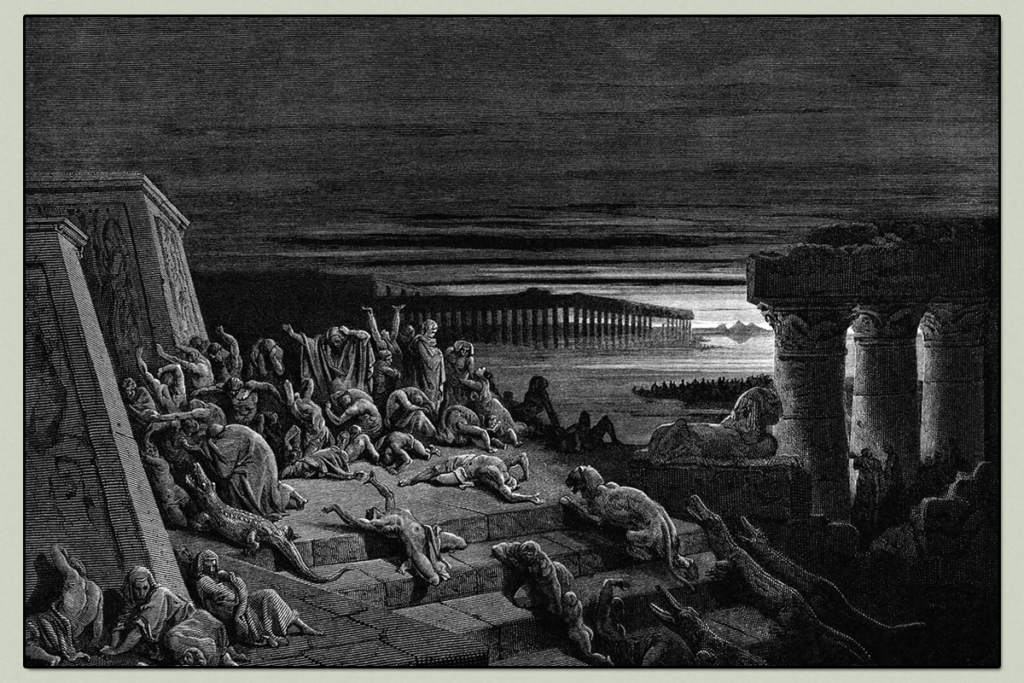
Dungeons and Dragons original concept was to replicate dark age/medieval Europe. Dungeons and Dragons takes place in a post-apocalyptic world. A world where an empire collapsed and knowledge has been lost. A world after a cataclysm, a massive plague or some event that left the land devastated. Dragonlance was one of the first settings I recall really nailing this.
Does D&D have to take place in such a world? No. But a campaign set in a world that is rebuilding, a world where lost knowledge is recovered, a world in which magic isn’t universally understood, a world where ancient ruins with ancient magic exist is an exciting world to be an adventurer.
The time after a cataclysmic event is also a time of significant change. For Europe, the depopulation that occurred because of the Black Death caused feudal lords to entice peasants with better housing and days of rest in order to get them to work the fields. They built churches and worked to improve the lives of the peasants.
Please don’t think I am saying the feudal lords made things perfect, but things went from a harsh life to a less harsh life and a blessing from a priest.
One of the most interesting times in European history for me is the Hundred Year Wars. This was a time of apocalypse for France. It was a defeated land, with French Knights unable to successfully engage against the English armies. A small section of the country remained under nominal control of the French monarchy. At least until a young woman from a small village named Domrémy went to the Dauphin of France and requested to be sent to the siege of Orleans. This 13-16 year old woman led the armies of France to victory against the English and reignited the spirit of France in the French people.
Why am I writing about Joan of Arc in a campaign builder workbook guide? Well, ever since I read the Mark Twain book about Joan of Arc I have been absolutely fascinated by her story. And whenever I do anything involving Dungeons and Dragons, I look to this time period in France for inspiration. It was weird and complicated. People lived their entire lives without knowing who ruled them. Danger came out of nowhere, but life could be very good. People could be happy. They married, raised families, and celebrated life and community.
In terms of the Local to Global methodology I keep thinking of how Mark Twain wrote about Domrémy, developed the characters and wrote about Joan’s adventures leading up to her death.
From a small village to the entire country of France, Joan of Arc led a remarkable life and saved France from being part of the United Kingdom. Her adventures needed a country in crisis to come about. Her finding the sword of Charles the Hammer Martel at the Church of Saint Catherine De Fierbois which she used to lift the siege of Orleans is more meaningful because of the crisis at hand. It was an important relic recovered at a critical time. Otherwise it would just be an interesting archaeological find.
The book and Netflix series The Last Kingdom begins in an England that has been fundamentally conquered by the Danes. It tells the story of a young English boy captured by the Danes, trained by the Dane, and then becomes the man who helps unify the kingdoms of England under the rule of one person.
England at that time was in an apocalypse. The norms of English life were devastated by the Vikings. (Honestly, watch The Vikings to get a glimpse of how it all started). And actually, the show The Vikings also presents a different version of apocalypse. The Norse farms weren’t able to support the growing population and exploration and conquering was the only way for their culture to survive.
A land in crisis is a land that needs heroes. You might not want to tell that kind of story with your players, but a land in crisis is the basis of great adventure. Keep that in mind as you build your campaign. Also, don’t be afraid to start your campaign pre-crisis to mix things up a bit. Game of Thrones was very much a pre-crisis land before someone needed chaos to create a ladder to ascend in power.
Let’s See What You Create
I would love to see what you create using this campaign builder workbook or share your methods for starting a homebrew campaign.
